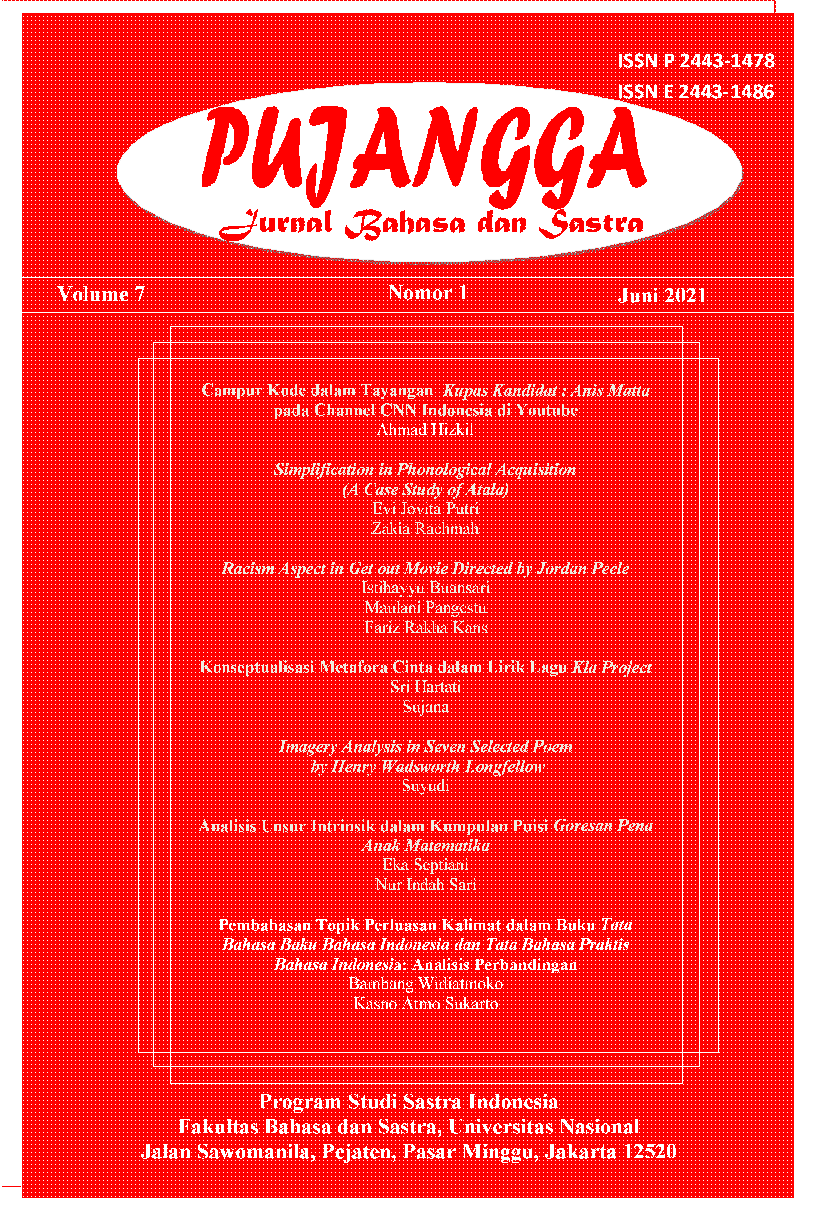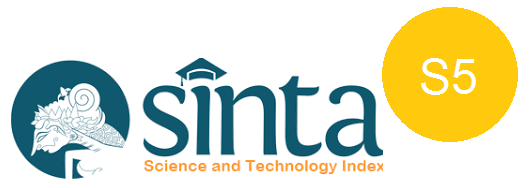RACISM ASPECT IN GET OUT MOVIE DIRECTED BY JORDAN PEELE
DOI:
https://doi.org/10.47313/pujangga.v7i1.1128Abstract
The purpose of this research is to determine all aspects of racism in the Get Out film, especially the type of racism, the effects of racism and the type of stereotype. This research used descriptive qualitative method. The data is collected through films that are watched repeatedly and analyzed by the writer and the writer looks for a theory that is in accordance with the observation process from the opinions of experts, journals, books, and social media, then compared with existing opinions. The author uses the theory of Samovar and Maher, well-known researchers who study racism and discrimination. The author found that the racism experienced by Chris Washington in the film Get Out was developed from the beginning to the end of the story. The result of the research film Racism is a belief system or doctrine which states that biological differences inherent in the human race determine cultural or individual attainment - that one race is superior and has the right to rule over another. The results of this study can be concluded that the types of racism are divided into two forms, namely Individual Racism and Micro-Aggression Racism. And also, this research can be concluded that there are two stereotypes of racism, namely discrimination and prejudice.
References
REFFERENCES
Arfani, S. (2018). The Schizophrenia in The Main Character of A Beautiful Mind movie Directed by Ron Howard. Wanastra: Jurnal Bahasa Dan Sastra, 10(1), 9–16. https://doi.org/10.31294/w.v10i1.2648
Arni. (2015). REPRESENTASI PERLAWANAN RASISME DALAM FILM THE HELP. In Journal of Chemical Information and Modeling (Vol. 110, Issue 9).
Arrow, K. J. (2015). The theory of discrimination. In Discrimination in Labor Markets. https://doi.org/10.1515/9781400867066-003
Association, A. P. (2016). Official Actions Position Statement on Resolution Against Racism and Racial Discrimination and Their Adverse Impacts on Mental Health. 10(May), 138511.
BARNET, S., BURTO, W., & CAIN, W. E. (2015). An Introduction to Literature. In Scandinavian Journal of Educational Research (Issue 1).
Bergstrand, K., & Jasper, J. M. (2018). Villains, Victims, and Heroes in Character Theory and Affect Control Theory. Social Psychology Quarterly, 81(3), 228–247. https://doi.org/10.1177/0190272518781050
Bogosyan, M. (2013). Racism. Racism and Cultural Diversity, 1(Racism).
Debora. (2017). BAB I. 1–7.
Devine, P. G. (2016). Stereotypes and Prejudice: Their Automatic and Controlled Components. Journal of Personality and Social Psychology. https://doi.org/10.1037/0022-3514.56.1.5
Grosfoguel, R. (2016). What is racism? Racism and Cultural Diversity, 22(1), 7–15. https://doi.org/10.4324/9780429479380-2
Humaira, Y. (2014). Rasisme Dalam Film Agathe Clèry Makalah Non-Seminar.
Lippert-Rasmussen, K. (2018). Discrimination. In The Oxford Handbook of Distributive Justice. https://doi.org/10.1093/oxfordhb/9780199645121.013.20
Literature, T., & Wolf, T. (2016). CHAPTER I. 1–5.
Moleong, L. J. (2012:330). (2013). Metode Penelitian. Journal of Chemical Information and Modeling, 53(9), 1689–1699.
Mulyana, F. (2019). TANDA-TANDA RASISME DALAM FILM “CEK TOKO SEBELAH”(ANALISIS SEMIOTIKA ROLAND BARTHES). 1036–1037.
Nuraeni, C. (2016). A Psychopath Analysis on Amy ’ s Character In Gone Girl Movie. Wanastra, VIII(2), 46–52.
O’Connor, A. (2017). The nature of prejudice. In The Nature of Prejudice. https://doi.org/10.4324/9781912282401
Rabiger, M. (2009). Directing Film Techniques and Aesthetics.
Romli. (2017). Konstruksi Konsep Diri Sepasang Remaja dalam Film Dua Garis Biru. Koneksi, 3(2), 447. https://doi.org/10.24912/kn.v3i2.6452
Sari, Y. (2015). The Values of Character Building Represented by Major Characters in The Novel of Negeri 5 Menara by A.Fuadi Translated by Angie Kilbane. 東京:音楽之友社:pp. 83-94.









